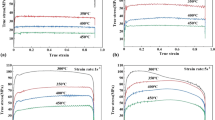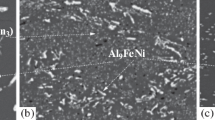Abstract
Hot deformation behavior of the new alloy 1580 sparingly doped with scandium (Al-5Mg-0.6Mn-0.10Sc-0.11Zr) was studied under the deformation temperature ranging from 350 to 450 °C and strain rate ranging from 0.01 to 10 s−1. Hot deformation by uniaxial compression and torsion was carried out on a Gleeble 3800 thermomechanical simulator. Hot deformation of the alloy 1580 is accompanied by dynamic softening with the establishment of a balance between the rates of nucleation and annihilation of dislocations. Alloy flow stresses increase with increasing strain rate and decreasing temperature. The experimental results for the new alloy are in full agreement with the known concepts that the combined effect of temperature and strain rate on the deformation behavior of metallic materials is described by the Zener-Hollomon parameter. The deformation activation energy of the alloy obtained by the regression analysis of steady-state flow stresses is 175.7 kJ/mol. When using the steady-state flow stresses normalized to the shear modulus, the deformation activation energy is 148.8 kJ/mol and is close to the activation energy of self-diffusion of aluminum. Analytical expressions are obtained for steady-state flow stresses as a function of the Zener-Hollomon parameter, which make it possible to predict the deformation resistance of the alloy 1580 in a wide range of temperatures and strain rates. This result is important for FEM modeling and for the choice of temperature and stain rate of hot deformation of the alloy under study. Comparison with the literature data showed that in the region of high temperatures and low strain rates, the flow stresses are weakly dependent on the scandium content in the alloy. However, with a decrease in the temperature and an increase in the strain rate, an increase in the scandium content in the alloys leads to a noticeable increase in the flow stresses. In torsion tests, a sharp increase in the ductility of the alloy is observed at a temperature of about 400 °C. One of its probable causes may be dissolution of particles Al3(Sc,Zr) during hot deformation in this high-temperature region.









Similar content being viewed by others
Availability of data and materials
Not applicable.
References
Zakharov VV, Filatov YA, Fisenko IA (2020) Scandium alloying of aluminum alloys. Metal Sci Heat Treatment 62(7–8):518–523. https://doi.org/10.1007/s11041-020-00595-0 Accessed 30 Apr 2021
Røyset J, Ryum N (2005) Scandium in aluminium alloys. Int Mater Rev 50(1):19–44. https://doi.org/10.1179/174328005X14311 Accessed 30 Apr 2021
Gorbunov JA (2015) The role and prospects of rare earth metals in the development of physical-mechanical characteristics and applications of deformable aluminum alloys. J Siberian Federal Univ Eng Technol 8(5):636–645 http://journal.sfu-kras.ru/en/article/19784 Accessed 30 Apr 2021
Konstantinov IL, Baranov VN, Sidelnikov SB, Kulikov BP, Bezrukikh AI, Frolov VF, Orelkina TA, Voroshilov DS, Yuryev PO, Belokonova IN (2020) Investigation of the structure and properties of cold-rolled strips from experimental alloy 1580 with a reduced scandium content. Int J Adv Manuf Technol 109(1-2):443–450. https://doi.org/10.1007/s00170-020-05681-4 Accessed 30 Apr 2021
Konstantinov IL, Baranov VN, Sidelnikov SB, Arnautov AD, Voroshilov DS, Dovzenko NN, Zenkin EY, Bezrukikh AI, Dovzenko IN, Yuryev PO (2021) Investigation of cold rolling modes of 1580 alloy by the method of computer simulation. Int J Adv Manuf Technol 112(7–8):1965–1972. https://doi.org/10.1007/s00170-020-06570-6 Accessed 30 Apr 2021
Dovzhenko NN, Demchenko AI, Bezrukikh AA, Dovzhenko IN, Baranov VN, Orelkina TA, Dementeva IS, Voroshilov DS, Gaevskiy VN, Lopatina ES (2021) Mechanical properties and microstructure of multi-pass butt weld of plates made of Al-Mg-Zr alloy sparingly doped with scandium. Int J Adv Manuf Technol 113(3–4):785–805. https://doi.org/10.1007/s00170-021-06665-8 Accessed 30 Apr 2021
Baranov V, Sidelnikov S, Voroshilov D, Yakivyuk O, Konstantinov I, Sokolov R, Belokonova I, Zenkin E, Frolov V (2018) Study of strength properties of semi-finished products from economically alloyed high-strength aluminium-scandium alloys for application in automobile transport and shipbuilding. Open Eng 8(1):69–76. https://doi.org/10.1515/eng-2018-0005 Accessed 30 Apr 2021
Shchitsin YD, Krivonosova EA, Neulubin SD, Olshanskaya TV, Nikulin RG, Fedoseeva EM, Terentyev SА (2019) Use of plasma surface for additive formation of aluminum alloys blade. Bulletin PNRPU Mech Eng Materials Sci 2:63–72. https://doi.org/10.15593/2224-9877/2019.2.08
Schmidtke K, Palm F, Hawkins A, Emmelmann C (2011) Process and mechanical properties: applicability of a scandium modified Al-alloy for laser additive manufacturing. Phys Procedia 12:369–374. https://doi.org/10.1016/j.phpro.2011.03.047 Accessed 30 Apr 2021
Sales A, Ricketts NJ (2019) Effect of scandium on wire arc additive manufacturing of 5 series aluminium alloys. Minerals Metals Mater Series:1455–1461. https://doi.org/10.1007/978-3-030-05864-7_182 Accessed 30 Apr 2021
Ren L, Gu H, Wang W (2020) The microstructure and properties of an Al-Mg-0.3Sc alloy deposited by wire arc additive manufacturing. Metals 10(3):320. https://doi.org/10.3390/met10030320 Accessed 30 Apr 2021
Rostova TD, Davydov VG, Yelagin VI, Zakharov VV (2000) Effect of scandium on recrystallization of aluminum and its alloys. Mater Sci Forum 331–337 II:793–798. https://doi.org/10.4028/www.scientific.net/MSF.331-337.793 Accessed 30 Apr 2021
Davydov VG, Rostova TD, Zakharov VV, Filatov YA, Yelagin VI (2000) Scientific principles of making an alloying addition of scandium to aluminium alloys. Mater Sci Eng A 280(1):30–36. https://doi.org/10.1016/S0921-5093(99)00652-8 Accessed 30 Apr 2021
Zakharov VV (2003) Effect of scandium on the structure and properties of aluminum alloys. Metal Sci Heat Treatment 45(7–8):246–253. https://doi.org/10.1023/A:1027368032062 Accessed 30 Apr 2021
Yin Z et al (2000) Effect of minor Sc and Zr on the microstructure and mechanical properties of Al–Mg based alloys. Mater Sci Eng A 280(1):151–155. https://doi.org/10.1016/S0921-5093(99)00682-6 Accessed 30 Apr 2021
Pan D, Zhou S, Zhang Z, Li M, Wu Y (2017) Effects of Sc(Zr) on the microstructure and mechanical properties of as-cast Al–Mg alloys. Mater Sci Technol 33(6):751–757. https://doi.org/10.1080/02670836.2016.1270573 Accessed 30 Apr 2021
Zakharov VV, Fisenko IA (2019) Some principles of alloying of aluminum alloys with scandium and zirconium in ingot production of deformed semiproducts. Metal Sci Heat Treatment 61(3–4):217–221. https://doi.org/10.1007/s11041-019-00403-4 Accessed 30 Apr 2021
Filatov YA, Yelagin VI, Zakharov VV (2000) New Al-Mg-Sc alloys. Mater Sci Eng A 280(1):97–101. https://doi.org/10.1016/S0921-5093(99)00673-5 Accessed 30 Apr 2021
Baranov VN, Sidelnikov SB, Zenkin EY, Voroshilov DS (2018) Development of fabrication modes of deformed semifinished products from the experimental scandium-containing aluminum alloy and investigation into their mechanical properties. Russian J Non-Ferrous Metals 59(1):62–66. https://doi.org/10.3103/S1067821218010042 Accessed 30 Apr 2021
Hugh J. (2017) McQueen, Stefano Spigarelli, Michael E. Kassner, Enrico Evangelista, Hot Deformation and Processing of Aluminum Alloys, CRC Press
Wells MA, Lloyd DJ, Samarasekera IV, Brimacombe JK, Hawbolt EB (1998) Modeling the microstructural changes during hot tandem rolling of AA5XXX aluminum alloys: part III. Overall model development and validation. Metall Mater Trans B Process Metall Mater Process Sci 29(3):709–719. https://doi.org/10.1007/s11663-998-0106-y Accessed 30 Apr 2021
Ahmed H, Wells MA, Maijer DM, Lockhart G, Winden MR (2007) Mathematical modeling of multipass hot deformation of aluminum alloy AA5083—model development and validation. Metall Mater Trans A 38(4):922–935. https://doi.org/10.1007/s11661-007-9101-1 Accessed 30 Apr 2021
Huang C, Liu L (2017) Application of the constitutive model in finite element simulation: predicting the flow behavior for 5754 aluminum alloy during hot working. Metals 7(9):331. https://doi.org/10.3390/met7090331 Accessed 30 Apr 2021
Dovzhenko IN, Dovzhenko NN, Sidelnikov SB, Konstantinov IL (2017) 3D modelling of the large-capacity ingots of an Al - Mg system aluminium alloy doped with scandium rolling process. Non-Ferrous Metals 43(2):60–64. https://doi.org/10.17580/nfm.2017.02.11 http://rudmet.net/media/articles/Article_NFM_02_17_pp.60-64_1.pdf Accessed 30 Apr 2021
Mann VK, Sidelnikov SB, Konstantinov IL, Baranov VN, Dovzhenko IN, Voroshilov DS, Lopatina ES, Yakivyuk OV, Belokonova IN (2019) Modeling and investigation of the process of hot rolling of large-sized ingots from aluminum alloy of the Al-Mg system, economically alloyed by scandium. Mater Sci Forum 943:58–65 10.4028/www.scientific.net/MSF.943.58 Accessed 30 Apr 2021
Yashin VV, Ruschits SV, Aryshensky EV, Latushkin IA (2019) Rheological behavior of 01570 and AA5182 wrought aluminum alloys under hot deformation conditions. Tsvetnye Metally 3:53–58. https://doi.org/10.17580/tsm.2019.03.09
Jiang J, Jiang F, Huang H, Zhang M, Tang Z, Tong M (2021) Hot deformation analysis and microstructure evolution of Al-Mg-Mn-Sc-Zr alloy by isothermal compression. J Alloys Compd 858:157655. https://doi.org/10.1016/j.jallcom.2020.157655 Accessed 30 Apr 2021
Lu L, Jiang F, Liu J, Tong M (2020) Study on rheological behavior and microstructural evolution of Al-6Mg-0.4Mn-0.15Sc-0.1Zr alloy by isothermal compression. Mater Res Express 7(5):056517. https://doi.org/10.1088/2053-1591/ab86f7 Accessed 30 Apr 2021
Yang D, Quan Y, Zhao H, Zhang Z, Huang G, Liu Q (2014) Effects of deformation heating on constitutive analysis of a new Al-Mg-Si-Cu alloy during hot compression. Mater Sci Forum 794–796:1263–1268. https://doi.org/10.4028/www.scientific.net/MSF.794-796.1263 Accessed 30 Apr 2021
Rushchits SV, Aryshensky EV, Sosedkov SM, Akhmed'yanov AM (2016) Modeling the hot deformation behavior of 1565ch aluminum alloy. Key Eng Mater 684:35–41. https://doi.org/10.4028/www.scientific.net/KEM.684.35 Accessed 30 Apr 2021
Dieter G.E., Kuhn H.A., Semiatin S.L., (2003) Eds. Handbook of Workability, ASM International.
Cabrera JM, Prado JM, Barrón MA (1999) An inverse analysis of the hot uniaxial compression test by means of the finite element method. Steel Res 70(2):59–66. https://doi.org/10.1002/srin.199905601 Accessed 30 Apr 2021
Kim WJ, Jeong HT (2019) Pronounced yield drop phenomenon at high temperatures in Al-Mg alloys with high contents of Mg (5–13 wt%). Mater Sci Eng A 743:590–596. https://doi.org/10.1016/j.msea.2018.11.102
Taleff EM, Nevland PJ, Krajewski PE (2001) Tensile ductility of several commercial aluminum alloys at elevated temperatures. Metallurgical Mater Transac A: Physical Metallurgy Mater Sci 32(5):123, 1119–123, 1130. https://doi.org/10.1007/s11661-001-0123-9 Accessed 30 Apr 2021
Huang H, Jiang F, Zhou J, Wei L, Zhong M, Liu X (2015) Hot deformation behavior and microstructural evolution of as-homogenized Al–6Mg–0.4Mn–0.25Sc–0.1Zr alloy during compression at elevated temperature. J Alloys Compd 644:862–872. https://doi.org/10.1016/j.jallcom.2015.05.048 Accessed 30 Apr 2021
Sellars CM, Tegart WJ (1972) Hot workability. Int Metallurgical Rev 17(1):1–24. https://doi.org/10.1179/imtlr.1972.17.1.1 Accessed 30 Apr 2021
McQueen HJ, Fry E, Belling J (2001) Comparative constitutive constants for hot working of Al-4.4Mg-0.7Mn (AA5083). J Mater Eng Perform 10(2):164–172. https://doi.org/10.1361/105994901770345178 Accessed 30 Apr 2021
Chen S-R, Wu C-Y, Yeh Y-L, Ou Y-L (2015) Hot deformation resistance of an AA5083 alloy under high strain rates. Key Eng Mater 626:553–560. https://doi.org/10.4028/www.scientific.net/KEM.626.553 Accessed 30 Apr 2021
Mirzadeh H, Cabrera JM, Najafizadeh A (2011) Constitutive relationships for hot deformation of austenite. Acta Mater 59:6441–6448. https://doi.org/10.1016/j.actamat.2011.07.008 Accessed 30 Apr 2021
Frost H.J., Ashby V.F.,(1982) Deformation Mechanism Maps. PERGAMON PRESS
Kaibyshev R, Musin F, Avtokratova E, Motohashi Y (2005) Deformation behavior of a modified 5083 aluminum alloy. Mater Sci Eng A 392(1–2):373–379. https://doi.org/10.1016/j.msea.2004.10.002 Accessed 30 Apr 2021
Mirzadeh H (2015) Constitutive description of 7075 aluminum alloy during hot deformation by apparent and physically-based approaches. J Mater Eng Perform 24(3):1095–1099. https://doi.org/10.1007/s11665-015-1389-1 Accessed 30 Apr 2021
Acknowledgements
The manuscript was prepared using the results of the work carried out during the project 03.G25.31.0265 “Development of economically alloyed high-strength Al-Sc alloys for use in road transport and navigation” in the framework of the Program for the implementation of complex projects for the creation of high-tech production, approved by the Government of the Russian Federation on April 9, 2010, №218.
Funding
The research was carried out within the framework of the state assignment of the Ministry of Science and Higher Education of the Russian Federation (scientific theme code FSRZ-2020-0011).
Author information
Authors and Affiliations
Contributions
The authors declare that they are all participants in the work and none of them performed only administrative functions.
Corresponding author
Ethics declarations
Ethical approval
The work contains no libelous or unlawful statements, does not infringe on the rights of others, or contain material or instructions that might cause harm or injury.
Consent to participate
The authors consent to participate.
Consent to publish
The authors consent to publish.
Competing interests
The authors declare no competing interests.
Additional information
Publisher’s note
Springer Nature remains neutral with regard to jurisdictional claims in published maps and institutional affiliations.
Rights and permissions
About this article
Cite this article
Dovzhenko, N.N., Rushchits, S.V., Dovzhenko, I.N. et al. Deformation behavior during hot processing of the alloy of the Al-Mg system economically doped with scandium. Int J Adv Manuf Technol 115, 2571–2579 (2021). https://doi.org/10.1007/s00170-021-07338-2
Received:
Accepted:
Published:
Issue Date:
DOI: https://doi.org/10.1007/s00170-021-07338-2




